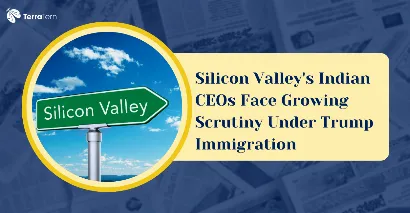Key Highlights
Indian-American leadership in the tech industry are under undue pressure as it is being redefined by a new administration led by Donald Trump, who is redefining immigration policies, screening foreign-born executives. When President Trump recently confronted Intel CEO Lip-Bu Tan on his affiliations to China, disturbing questions have arisen whether CEOs of other diaspora nations, especially those of Indian CEOs, are likely to be treated the same way.
Also Read: How Many Types of Visa in USA? New Full Expert Guide
The Intel Precedent: A Warning Sign for Indian Executives
What is worrying is that president Trump has compelled Intel CEO Lip-Bu Tan to become much more like him and resign immediately, citing that he is highly conflicted, as it is a deplorable change in how this administration would regard foreign-born technology headsTan reaped political baggageed was his Malaysian ethnnicity and his history of investing in Chinese firms with his venture capital company Walden International. His investment record in a hundred-plus companies was profitable, but Tan became politically vulnerable due to improper relations between politicians in China and business.
This precedent leaves the influential Indian diaspora of Silicon Valley in a state of anxiety, and they have always been treated well politically, as India was a strategic partner to the U.S., as opposed to a competitor like China.
H1-B Visa Policy Changes Target Indian Tech Workers
Immigration has turned out to be unfriendly to Indian professionals who comprise more than 70 per cent of the people who apply for H1-B visas. New developments that the U.S. State Department announced are intended to enforce a requirement of in-person interviews for all H1-B applicants beginning September 2, 2025, and end the convenient Dropbox waiver program.
This change primarily affects Silicon Valley, ranked second nationwide in H1-B visa approvals (2021-2024). Out of the 78000 workers approved to work in H1-B, the number of workers already working in Silicon Valley in 2024 was over 39000, with most being Indians.
Also Read: Cost of Transit Visa for USA: New Fees & Process Guide
Key H1-B Policy Changes for 2025
|
Change |
Impact |
Effective Date |
|
Mandatory in-person interviews |
Increased processing delays and costs |
September 2, 2025 |
|
Elimination of the Dropbox facility |
Travel requirements to home countries |
September 2, 2025 |
|
Potential lottery system overhaul |
Preference for higher-wage workers |
Under review |
Trump's Anti-Immigration Rhetoric Targets Indian Workers
President Trump has come out strongly against the employment of Indian workers as he recently said at a tech summit: However, many of our most prominent tech companies have embraced the benefits of American freedom and have built their factories in China, hire workers in India and store their profits in Ireland. Days like that are gone under President Trump".
The rhetoric is a significant turnaround of what happened in past governing groups, and it poses an immediate risk to the careers of Indian professionals working in American technology companies.
Impact on Major Tech Companies
According to corporate giants such as Google, Amazon and Meta, they have told their holders of the H1-B visa to stay put on American soil because they are likely to be barred upon their return. Such an extreme reaction of the corporation reveals the gravity of the situation with immigration.
Indian CEO Success Stories Under Threat
Indian-American executives in Silicon Valley have been highly successful, and there are leaders such as:
-
Sundar Pichai is the CEO of Alphabet Inc.
-
Satya Nadella- Microsoft Corp. CEO.
-
Shantanu Narayen, CEO of Adobe Inc.
-
Arvind Krishna - IBMCorpp. CEO.
In part, this owes to the historical role that India has played as an ally of the U.S. and not a strategic rival. Nevertheless, this positive perception is changing because the technology industry in India is increasingly independent and competitive.
Economic Implications of Indian Leadership
|
Company |
Indian CEO |
Market Cap Impact |
|
Microsoft |
Satya Nadella |
$3.2 trillion growth during tenure |
|
Alphabet |
Sundar Pichai |
Sustained innovation leadership |
|
Adobe |
Shantanu Narayen |
Creative software market dominance |
Also Read: Difference Between B1 and B2 Visa USA: Experts New Guide
Changing Political Climate and Future Challenges
The mercantilist worldview of the Trump administration is incredulous toward cooperation with prospective future competitors. The threatened 50 per cent tariff rate in India shows that the president can fail to separate the path between India and China; this way, the Indian-American leaders may face a similar vigilance.
Cosmopolitan minorities find it difficult in an economically nationalistic and competitive industrial policy. Traditionally tricky at times of populist governments, "dual loyalty" demagoguery may re-emerge as the Indian tech industry becomes more widely known worldwide.
Industry Response and Adaptation Strategies
Tech companies are coping with the new situation by:
-
Warning the H1-B workers not to travel overseas
-
Ordering food to keep escrowed visas in cases of long delays in processing visas
-
Pursuing other types of visas
-
Investing in local development of talent
Professor Bill Hing of the University of San Francisco teaches Law and Migration Studies and notes that long delays may result in visa holders remaining stranded in India or China and having no way to get back to work.
Also Read: Difference Between Tourist Visa and Visitor Visa
Future Outlook for Indian Tech Professionals
Towards the backdrop of migration policies getting tougher, the introduction of mandatory interview requirements as well as political jargons portraying the Indian workers as a thorn in the side of the economy, bring about uncertaintyforo for the future. Several skilled immigrants are opting to come back to India to create companies. It has been forecasted that India may find several Silicon Valley-calibre tech melting pots within 10 years.
Vivek Wadhwa, the CEO of Vionix Biosciences, cautions that the Trump administration could worsen the situation for skilled foreign workers. This immigration debate will also blow up in the face of America because very talented people will take their innovation home.
Conclusion
The H1-B visa and the increasing attention on Indian CEOs in Silicon Valley are a paradigm shift in the American immigration trends and the technology sector. With Trump putting a new face on the employment of skilled foreign workers, the Indian-American executives who have long served as the American success story might soon be experiencing the same political heat that was put on Intel executive Lip-Bu Tan. The high dependence of the tech sector on foreign talent, especially Indian talent, remains under a cloud as this policy reform progresses throughout 2025. Contact TerraTern for more information!








